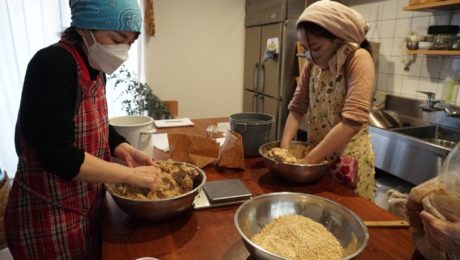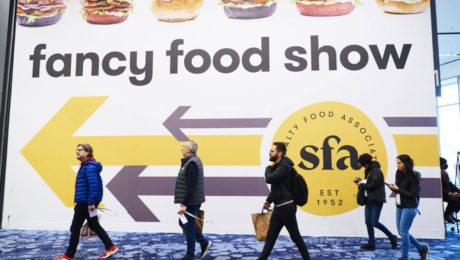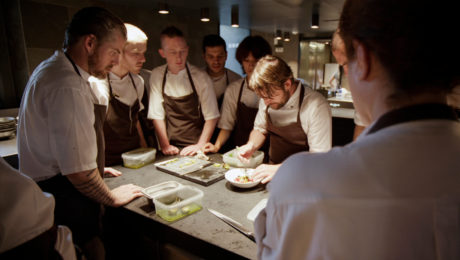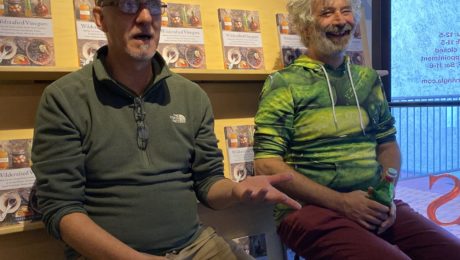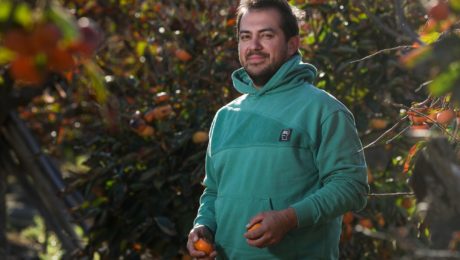FDA: Pickles & Yogurt “Unhealthy”?
Pickle and yogurt brands are speaking out against new labeling rules proposed by the U.S. Food and Drug Administration. The FDA’s new guidelines say some brands of the fermented products cannot be marketed as healthy because pickles are too salty, while some yogurt has too much sugar.
The guidelines are being updated for the first time since the 90’s. They redefine what can be labeled as “healthy” on a food package. Healthy products have high amounts of key nutritious ingredients, like fruits and vegetables, and low amounts of added sugar, sodium and/or saturated fat. Those updated nutrient content claims would go into effect in 2026. They wouldn’t ban “unhealthy” foods, but prevent the use of “healthy” on a label.
“Pickles have a role to play in a healthy diet because they are predominantly comprised of vegetables and serve as a delicious condiment to other nutrient-dense foods,” Pickle Packers International said in a statement.
Though pickles are made from low-sodium cucumbers, they are either fermented through a brine made of water, salt and seasonings or preserved in a brine of vinegar, salt and seasonings. Without enough salt in the brine, bacteria can grow and spoil the pickles. The new guidelines put the limit for sodium from a vegetable product at 10% of the daily value per serving (230 milligrams per serving). But most pickles include 11% sodium per serving.
Yogurt, too, is under fire. The new guidelines outline that a ¾ cup of yogurt should only include 5% per serving of the daily value of sugar (2.5 grams of added sugar per serving). Chobani’s plain greek yogurt includes 5.5 grams of sugar per serving. Chobani has actively protested the FDA’s ruling, noting that “reducing sugars to the level proposed by FDA for the ‘healthy’ claim would result in significant, deleterious effects to product quality, taste, and texture.”
Other companies are protesting the FDA’s guidelines – like General Mills, Kellogg’s, SNA International, the National Pasta Association and the Consumer Brands Association. The FDA guidelines put tighter restrictions on cereal and pasta, too.
“Hardly anything would qualify, so of course food manufacturers don’t like the idea,” says Marion Nestle, emeritus professor of nutrition and public health at New York University. She told nutrition and medicine publication STAT that the FDA’s regulation “automatically excludes the vast majority of heavily processed foods in supermarkets, as well as a lot of plant-based meat, eggs, and dairy products,” from bearing the healthy claim.
The publication notes nutrition experts gave “overwhelmingly positive remarks.” The new guidelines are supported by the American Society for Nutrition, the Association of State Public Health Nutritionists and the Robert Wood Johnson Foundation. Some experts argued the GDA could go further in restricting the healthy label.
Read more (STAT)
- Published in Food & Flavor, Health
Japan Turns to Fermented Foods for Food Waste Solution
In Japan, more and more food producers are turning to fermentation as a cost-effective and nutritious way to give new life to food waste. It comes at a critical time, as the Japanese government has made an ambitious plan to halve food waste by 2030.
Fermentation has deep-rooted tradition in Japan, where kōji-based products like miso and sake were first made centuries ago (pictured, students in a miso class mix soybeans with kōji rice and salt). Japan Times outlines how Japanese producers are experimenting with fermentation to combat climate change:
- For example, multiple Japanese beermakers are using food scraps in their brewing. Chiba Upcycling Lab is using bread waste, Rise & Win brewery uses yuzu peel and Ashai uses spent coffee grounds.
- The Japan Food Ecology Center produces pig feed using lactic acid bacteria to ferment 39 metric tons of food scraps a day that come from 180 businesses.
- Tokyo-based Food Alchemist Lab is making plant-based salami using kōji, nuts and vegetable fibers, including juice production scraps.
Key is “combining ancient fermentation knowledge with novel approaches,” the article continues.
“Microorganisms have given us miso, sake and soy sauce. Now they can help save the planet,” says Tomas Linder, associate professor and senior lecturer in microbiology at the Swedish University of Agricultural Sciences in Uppsala.
Read more (Japan Times)
- Published in Business, Food & Flavor
Bringing Injera to U.S. Diners
A California-based Ethiopian chef is making some creative takeout offerings. Serkaddis Alemu of Santa Barbara Ethiopian restaurant Petit Valentien now sells DIY injera kits, for customers to create the fermented flatbread at home.
“Don’t call it bread; don’t call it crȇpes: Injera is injera,” Alemu says (pictured with her husband and daughters). “With fermentation, you really can’t cut corners.”
Injera is a spongy, sour, pancake-like flatbread. It is made of teff flour, a nutrient-dense flour that grows in the highlands of Ethiopia. Injera is a staple in Ethiopia, and TFA predicts it’s poised to become a popular fermented food in the U.S.
The $49 kit contains an instructional guide, video links, one pound of ivory teff, one pound of brown teff and Alemu’s mother dough.
Alemu says slowing down will be the biggest challenge for some home cooks making their own injera. Fermentation of injera takes between one and six days, depending on the desired flavor outcome. She hopes the kit will help inspire others to ferment.
Read more (Santa Barbara Independent)
- Published in Food & Flavor
Fermentation is Not a Trend
Fermentation intersects several major food movements – it’s natural, artisanal, sustainable, innovative, functional, global, flavorful and healthy. Now is an ideal time in the food market for fermentation producers.
“Fermentation is not a trend. It’s experiencing a resurgence, a renaissance,” says Amelia Nielson-Stowell, editor of The Fermentation Association. “Fermentation never went away. It just became less of a common type of food craft, especially in the U.S. where Americans became accustomed to other types of food processing.”
Nielson-Stowell was a speaker at the Specialty Food Association’s Winter Fancy Food Show in Las Vegas. Her remarks touched on growth opportunities and challenges for the fermentation industry. It was well-received by the audience. Two food business news magazines wrote articles about it. The show’s keynote speaker, author Paco Underhill, was also in attendance and brought up Nielson-Stowell’s presentation during his keynote.
Fermentation is a growing industry, slated to reach $846 billion in global sales by 2027. Kvass, pickles, kimchi and hard cider are the products experiencing the largest growth.
There’s no denying fermentation’s popularity – “there’s widespread scientific agreement that eating fermented foods will help the microorganisms in your gut,” Nielson-Stowell explains. But reputable clinical trials proving the health benefits of fermented foods are few and far between because they’re incredibly expensive to conduct. There are plenty of studies on the health benefits of yogurt because there’s a lot of money in the dairy industry. Other ferments don’t have the monetary backing, she adds.
Nielson-Stowell points to the 2021 Stanford study as a “watershed moment” in fermentation. It’s one of the first clinical trials proving diet remodels the gut microbiota. The research, published in the journal Cell, found a diet high in fermented food like yogurt, kefir, cottage cheese, kimchi, kombucha, fermented veggies and fermented veggie broth led to an increase in overall microbial diversity.
“This microbiome world we are in right now is a real opportune time to talk to consumers about fermented foods and health,” Nielson-Stowell said. “Humans have long consumed fermented foods for thousands and thousands of years, but now we have the scientific techniques to dive into fermented foods and analyze their nutritional properties, their microbial composition and better understand how they may improve a person’s health.”
Educating consumers is another major challenge. Nielsen-Stowell encourages brands to focus on simple messaging, then delve deeper into the science on their webpage for consumer’s that want to know more about the intricacies of their food.
“Many consumers are confused about fermentation. They know it’s good for them, but they don’t understand why or what products are fermented,” she said.
Tradition, too, should be shared.
“Fermented foods have a unique story to them compared to other foods,” she adds. “Every culture in the world has a traditional ferment. We are here today because, thousands of years ago, our ancestors fermented.”
- Published in Food & Flavor, Health
Noma Announces End of Restaurant; Hires for Food Lab
Noma – the New Nordic restaurant that inspired the restaurant fermentation movement – announced it will be closing in 2024, reopening as a food lab. This reiteration (owner René Redzepi calls it Noma 3.0) will focus on developing new dishes and products for Noma Projects, Noma’s e-commerce, CPG operation.
Within days of the news, Noma announced the hire of Arielle Johnson, PhD, as Noma Projects’ Science Director. Johnson, a flavor scientist, food chemist and gastronomy researcher, co-founded the Noma Fermentation Lab in 2014.
Since first opening two decades ago, Noma has been named one of the world’s best restaurants. The announcement shocked the restaurant industry as Noma is seemingly at the top of their game. Noma redefined fine dining – meals at Noma were largely local, Nordic ingredients turned into artistically beautiful and culinarily unique dishes.
“The style of fine dining that Noma helped create and promote around the globe — wildly innovative, labor-intensive and vastly expensive — may be undergoing a sustainability crisis,” writes the New York Times.
Redzepi himself says the long hours and fair compensation for the large team “is not workable.” Noma came under fire for their stagiaire program, the term for unpaid restaurant interns. Noma started paying their interns in October 2022.
“We have to completely rethink the industry,” he told the Times. “This is simply too hard, and we have to work in a different way.”
“Fine dining is at a crossroads, and there have to be huge changes,” he said. “The whole industry realizes that, but they do not know how it’s going to come out.”
Read more (New York Times)
- Published in Business, Food & Flavor
Food and Beverage Laws Passed in 2022
Two-and-a-half years into the Covid-19 pandemic, state legislators continue to pass laws aiming to aid food businesses impacted by the pandemic.
Bills passed in the 2022 legislative session further loosen the reins on the archaic alcohol laws that dominate state alcohol departments, permanently adopt formerly temporary laws aimed to help restaurants survive the pandemic, expand cottage food laws for the growing amount of home-based producers and help farmers by setting standards on the amount of local, farm-grown produce public institutions need to be purchasing.
More states are also aiming to become more green, banning PFAS food packaging, limiting single-serving utensils and requiring produce checkout bags to be compostable.
Below are the key food, beverage and food service laws passed in 2022. They are listed alphabetically in this article, Alabama through Maryland. We’ll feature the balance of the states — Massachusetts to Wyoming — in TFA’s next newsletter (January 25, 2023).
Alabama
SB22 — Allows retail establishments to serve wine for off-premise consumption, redacting the former bill that only allows for wine to be consumed on-site.
Alaska
SB9 — A comprehensive overhaul of the state’s 40-year-old alcohol licensing statute. Allows the state’s Alcohol Beverage Control Board (ABC) to issue licenses to government entities and tribal groups. The modernization eliminates bureaucratic red tape by extending tasting room operating hours, allows live concerts at taprooms and allows small communities to track mail and online alcohol sales to eliminate bootlegging.
HB298 — Establishes a task force on Alaska’s food systems and sovereignty.
Arizona
SB1248 — Deems it unlawful for a supplier to coerce a wholesaler to accept a delivery of beer that was not ordered or canceled.
HB2660 — Updates liquor licensing procedures.
California
AB 257 — Known as the Fast Food Accountability and Standards Recovery Act, it establishes the state’s first Fast Food Council to establish minimum standards on wages, working hours and health-, safety- and welfare-related conditions.
AB778 — Requires state institutions to purchase 60% California-grown food, in season.
AB1825 — Standardizes regulations regarding shipment and transport of California fruit, nut and vegetables.
AB2971 — Allows beer manufacturers to give up to five cases of retail advertising glassware to an on-sale retail licensee.
SB490 — The Buy American Food Act. Requires all state public institutions that receive federal reimbursements for meals to only purchase food products grown, packed or processed in the United States.
SB793 — Allows the Department of Alcoholic Beverage Control to issue a music venue license that would allow the licensee to sell beer, wine and distilled spirits at the entertainment facility.
SB 982 — Creates a certified organic apple program for apples grown in California.
SB 972 — Modifies the California Retail Food Code, allowing sidewalk food vendors to obtain public health permits. The new Compact Mobile Food Operation (CMFO) is defined as a non-motorized push-cart, stand, rack or display, pedal-driven cart or wage that must be cleaned and stored daily.
SB1013 — Adds wine and distilled spirits to the state’s recycling container redemption program.
SB1046 — Requires pre-checkout, produce bags in grocery stores to be reusable, recyclable or compostable.
SB1370 — Authorizes a theater company and a nonprofit radio broadcasting company that holds a license to sell and serve alcohol to also sell alcohol two hours before and one hour after the event.
Colorado
HB1017 — Increases the amount of alcohol beverages brought into the state that would be exempt from taxes.
Connecticut
HB5146 — Act Concerning Food Donation, makes it easier for supermarkets to donate their edible surplus produce or other food items to food relief organizations that are in need.
HB5271 — Extends temporary provisions put in place during Covid-19 for temporary outdoor food and beverage services.
SB187 — Increases maximum gross sales for cottage food operations from $25,000 to $50,000.
Delaware
HB46 — Permits brewery-pub and microbrewery license holders to brew, bottle and sell hard seltzers and other fermented beverages made from malt substitutes. Formerly, license holders could not brew hard seltzers or other non-malt based products without obtaining a Federal Brewer’s Notice.
HB81 — Allows two or more microbreweries to share brewing equipment if the microbreweries maintain separate premises to sell their product to consumers and wholesalers.
HB98 — Allows importers to take orders from retailers any day including Sundays and holidays and process them for delivery.
HB143 — Removes taprooms from the list of establishments that a commissioner can refuse to grant an alcohol license to when there is an existing licensed establishment of similar type within a specified distance.
HB226 — Extends immunity from civil or criminal liability to those who donate food to nonprofit organizations. Includes those who donate perishable food and wild game.
HB289 — Allows liquor stores, farm wineries, brewery-pubs, microbreweries, craft distilleries and wine auctions to provide curbside service. Sales are prohibited to intoxicated persons or persons under 21 years of age.
HB290 — Permanently removes the sunset provision of House Bill 1 that allowed food and drink establishments who suffered loss during the Covid-19 pandemic to continue selling alcoholic beverages in take-out, curbside or drive-through services — and to use outdoor seating for serving food and drinks.
HB427 — Allows persons 14 and 15 years old to be employed in places where alcoholic beverages are served, but not selling or serving alcohol.
HB463 — Amends current alcohol law, allowing a person 18 years or older to enter a tavern or taproom to pick up a food order for delivery through a third-party delivery service. Also allows a person 18 years or older to work in a tavern or taproom selling or serving alcohol as long as they’re not preparing alcohol.
SB46 — Amends current alcohol law, permitting wedding venues and other rental venues licensed as a bottle club to allow customers to bring alcoholic beverages
SB304 — Corrects code related to the regulation of seeds sold in the state.
SB334 — Allows restaurants that sell ice cream containing up to 10% alcohol by volume to sell such ice cream without the requirement to purchase at least $10 of food.
Georgia
HB1175 — The Georgia Raw Dairy Act. Authorizes and regulates the production, handling, transporting and sale of raw milk and raw milk products for human consumption. It also provides standards for safety, cleanliness and health for such products and animals producing them.
HB1443 — Allows mobile food service establishments that have active permits to operate in the state state, not just the county of origin as the bill previously allowed.
SB396 — Renames Georgia State Nutrition Assistance Program (SNAP) to the Georgia Grown Farm to Food Bank Program (F2FB). It requires food procured to be Georgia grown.
Hawaii
HB1568 — Requires public institutions to ensure a certain percentage of food purchased for public schools, youth campuses, public hospitals, public prisons and University of Hawaii system academic programs consists of fresh, local agricultural products. Requires an annual benchmark report from public institutions on their efforts.
SB335 — Requires the Hawaii Department of Agriculture to annually lease at least 50% of land leased or up for lease renewal to operations whose primary business is, or supports, local food production.
SB2331 — Expands the definition of “beer” under the state’s liquor tax and liquor regulatory laws to specify that the term includes an alcohol by volume of no less than 0.5% and alcohol seltzer beverages.
SB2992 — Establishes the Hawaii agricultural investment program to support local agricultural producers.
SB2960 — Requires the Department of Agriculture to partner with Hawaii’s agricultural community to establish and implement a food safety certification training program to help small- to medium-sized farms comply with federal food safety certification mandates.
SB3197 — Establishes a farmer apprentice mentorship program, encouraging young farmers in the state.
SB 2664 — Protects agricultural lands that grow taro, a native crop to Hawaii. Fermented taro is used to make poi, a popular Polynesian dish.
Idaho
HB646 — Expands definition of alcoholic beverages to include mead, cider and other fermented fruit juice beverages for personal use and to provide for the use and storage of homemade beer, wine and other fermented beverages at licensed premises.
HB744 — Allows distillers to donate their own liquor to charity, previously an illegal act.
Illinois
HB209 — Creates the Latex Glove Ban Act, banning use of latex gloves for use in commercial food prep.
HB2382 — Creates the Healthy Food Program Development Act, expanding access to healthy foods in eligible areas in the State by providing assistance to grocery stores, corner stores, farmers’ markets and other small food retailers.
SB3838 — Amends the Food Handling Regulation Enforcement Act. Provides that a farmer who sells meat, poultry, eggs or dairy products from the premises of the farmer’s farm is exempt from licensing by the farmer’s local health department under specified conditions. Provides that local health departments may issue Farmers’ Market Retail Permits for the sale of products at farmers’ markets and at semi-permanent events.
Indiana
HB1149 — Expands the cottage food law by allowing all direct sales of almost all nonperishable foods made by home-based vendors (except acidified canned goods), including online sales and in-state shipping. Requires an individual who sells poultry, rabbits, and eggs at a farmers’ market or roadside stand to comply with certain requirements.
HB1298 — Provides the alcohol and tobacco commission may not require physical separation between a bar area and a dining area in a food hall. Creates a temporary craft manufacturer hospitality permit that allows a craft manufacturer to participate in a convention, trade show, exposition or similar event on the licensed premises of a particular host permittee.
Iowa
HF2431 — Updates Iowa’s cottage food laws from “home bakeries” to “home food processing establishments.” Allows cottage food producers to sell most types of homemade food, including acidified canned goods, meat and poultry. Also allows cottage food businesses to sell online and ship products. Increases the sale limit for home food processors from $35,000 to $50,000.
SF2290 — Creates the Dairy Processing and Milk Production Innovation and Revitalization program, to aid the dairy industry in recovering from the pandemic and expand career opportunities and industry development in rural Iowa. Creates an artisanal dairy study to explore establishing an artisanal dairy processing program at a community college or university.
SF2374 — Overhaul of Iowa’s liquor licensing classifications. Allows Class C liquor licenses to purchase up to five cases of beer, high alcohol content beer or canned cocktails at any retailer, every 24 hours. It also includes Sunday Sales privileges on all Class C licenses. Includes fines for third-party food delivery services that use a restaurant’s logo or menu without permission. Also changes how Iowans can redeem beer and soda cans and bottles to collect nickel deposits.
Kansas
SB2 — Allows consumption of beer, wine or other alcoholic liquor on the Kansas state fairgrounds. Increases the number of temporary permits an applicant may receive from four to 12 permits per year.
SB346 — Allows on-farm sales of raw milk, with a label identifying the product as unpasteurized.
Kentucky
HB252 — Amends alcohol law to lower the minimum server age of employees to 18 and to exclude persons under the age of 20 from bartending.
HB500 — Modernizes Kentucky alcohol laws to aid the state’s thriving bourbon industry. Legalizes sales of barrel-aged and batched cocktails, a practice formerly not authorized in Kentucky since the alcohol was not poured from its original container. Authorizes private barrel selection events, allows distillers to sell exclusive bottles on-site at distillery gift shops, authorizes distilleries to open a satellite tasting room and allows distillers to offer complimentary samples and sell bottles at fairs, festivals and farmer’s markets.
HR15 — A resolution recognizing March 22, 2022, as National Agriculture Day.
HR21 — A resolution recognizing October 12, 2022, as National Farmers Day.
HR31 — A resolution recognizing May 2022 as National Beef Month in Kentucky.
HR35 — A resolution recognizing June 2022 as National Dairy Month.
Louisiana
HB370 — Allows for self-distribution of beer or other malt beverages by in-state brewers.
HB523 — Allows licensed manufacturers or brewers of alcoholic beverages to host contracted private events at brewing facilities.
HB828 — Updates the state’s cottage food law, increasing the gross annual sales threshold under which a home-based preparer of low-risk foods may qualify for the protections of the statute known commonly as the cottage food law.
HB829 — Updates third-party alcoholic beverage delivery laws to clarify the delivery distance radius, necessary permits and penalties.
HR 78 — A resolution asking Congress to require the Food and Drug Administration to fulfill its duties related to the inspection and testing of imported seafood and to support the Illegal Fishing and Forced Labor Prevention Act. Collaboratively, these efforts would help restore economic opportunities for Louisiana’s fishing industries, protect the health of consumers, and make the international seafood trade safer for workers
SB450 — Allows a licensed wholesaler to transfer beverages between microbreweries.
Maine
LD1503 — Prohibits the use of toxic “forever chemicals” called perfluoroalkyl and polyfluoroalkyl substances (PFAS) in various products, including food packaging and cookware.
Maryland
HB 178 — Alters the definition of cottage food business to increase the cap on the annual revenues from the sale of cottage food products from $25,000 to $50,000.
HB275 — Prohibits a person from manufacturing, selling or distributing products with PFAS chemicals in the state of Maryland, including in food packaging.
SB569 — Extends the application dates of certain provisions related to certain holders of Class 4 limited winery licenses.
- Published in Business, Food & Flavor
Fermenting Wild Foods
Wild food expert Pascal Baudar says the fact that we can buy tomatoes in the store year round “is freaky.” We should be eating food in season, and we’re ignoring the plethora of sustainable cuisine available in nature, edible food hikers overlook and cities destroy.
“One of the things I started realizing doing foraging is it’s really about food preservation techniques,” says Baudar, author of four books on traditional food preservation. “As a forager, plants go through different phases, but I have to find a way to preserve it so I can still eat my plants in the winter.”
Baudar and Sandor Katz, author of multiple books on fermentation, shared an intimate stage at cookbook store Now Serving LA in Los Angeles to promote Baudar’s latest book, Wildcrafted Vinegars. The two rockstars of fermentation encouraged the crowd to connect with the resources around them.
The Foraging Craft
Baudar learned foraging as a child from his grandmother. He grew up in Belgium, France in a rural town of just 1,000 people. “I really enjoyed this connection with the environment and the forest,” he says. He wanted to study it more – but, at the time, the only books on the subject of foraging wild plants and living with the environment were about witchcraft. He studied fine art instead, eventually becoming a graphic designer.
Nervous about the much hyped Y2K scare, he began foraging again in 1999. But this time he decided he wanted to really live it. In just a few years, he took hundreds of classes from native people, botanists and survivalists, learning about native plants and how to find and eat them.
Today, Baudar lives in the Angeles National Forest in San Bernardino County. He teaches classes on subjects like eco-friendly foraging and plant identification. He admits he had no desire to get into fermentation when he began foraging. But eating wild plants meant he had to master food preservation techniques to eat the food year round, which he covers in his books (like Wildcrafted Fermentation). He learned there are three bacteria types that can be foraged locally – lactic acid, acetic acid and yeasts – their transformative microbial power harnessed through fermentation.
“My main job is to rediscover what people did in the old days,” Baudar says. “I’m not a crusader, I’m a teacher more than anything else.”
Biodiversity of Fermenting
Katz, meanwhile, was drawn to fermentation from gardening. Raised in New York’s Upper West Side, Katz eventually moved to a rural, off-the-grid community in Tennessee as a young adult. He planted a garden and learned to live a slower lifestyle.
“I was such a naïve city kid, I didn’t realize all the cabbage would be ready at the same time,” Katz says of his first garden. He learned to ferment sauerkraut first – garnering the nickname “Sandor Kraut” – and become a self-described “fermentation fetishist” from there.
“My interest in fermentation stems from my desire to get closer to where my food comes from. A lot of people have a craving to be more connected to their food,” says Katz. “Learning about common, wild plants and accessing them is a great way to do that. You get to know your environment better.”
Katz is known worldwide as a fermentation revivalist, bringing a renewed interest in the ancient food craft, especially in the U.S. He always preaches on fermentation’s safety.
“Fermentation is above all else a strategy for safety,” he says. “In the realm of raw fruits or vegetables, there are no cases of food poisoning from fermentation.”
Immersing vegetables into salt and water allows the lactic acid bacteria on the vegetables to thrive. If there were salmonella on a vegetable, for example, fermenting it creates an acidic environment where salmonella can’t survive.
“Acidification and alcohol are really strategies for safety because they make it impossible for the pathogens to grow,” he adds. “Everything we eat raw has incredible biodiversity on it that we don’t even recognize. The question of which of those organisms are going to become dominant for the fermentation, that’s what it’s all about, really. Manipulating the environmental conditions to encourage the ones we want and discourage the ones we don’t want.”
Hunting for Wild Plants
There’s an element to safety in foraging, too, “you really have to know what you’re doing,” Baudar cautions. “There are some plants that will definitely kill you. You have to go with certainty.”
Baudar will not forage in the city, though, especially along major roadways. The pollution in major metropolitan areas gets in the plants – he hunts in more pristine environments.
“You have to know where to forage,” he says. Still, people have healthy urban gardens. “Modern agriculture in my opinion is way worse than whatever you can forwage, with the amount of chemicals they put on there”
Baudar currently lives in an RV on property over 130 miles away from the city of Los Angeles. He moved from the city during the Covid-19 pandemic.
“One of the things I learned doing this is Los Angeles is really the capital of wild food,” he says. “Los Angeles is incredible in terms of wild, edible plants. What is fascinating is 90% of the wild, edible plants around Los Angeles are actually native and invasive.”
He points to the foothills and mountainsides surrounding Los Angeles and Southern California. In the spring, they’re a bright yellow color, covered with roughly 12 different types of wild mustard. Mustard could easily be preserved and put in the food stream – Baudar says other countries do this with wild mustard – but in California, the mustard is sprayed with Round Up and ripped out.
“The biggest food waste in Los Angeles is wild plants,” he adds. “But no one ever looks at wild food as food waste.”
Noma restaurant in Denmark is an excellent example of foraging. There was no Nordic cuisine based in native native plants until Noma revived it. “They practically rediscovered cuisine from scratch in the early 2000s,” he says.
Think of California cuisine and a modge podge of food from other cultures comes to mind – Mexican or Vietnamese food. California doesn’t have an identity with their native food. Baudar says every state could have their own sustainable cuisine based on edible, wild food.
“If you cook California cuisine in 2023, cuisine that is actually good for the environment by cooking those non-native and native plants, cuisine that’s sustainable because you’re replanting the plants, that’s native cuisine. And you do it without cultural appropriation because it’s native plants,” he says. “And it tastes really, really good. But foraging is not part of the big picture (for governments).”
- Published in Food & Flavor
Ugly Fruit into Delicious Kombucha
A new Los Angeles-based kombucha brand has a unique approach to their fermented tea. Sunset Cultures owner and chef Balo Orozco (pictured) uses the unsold or “ugly” fruits and vegetables from local farms into “some of L.A.’s most creative kombuchas, hot sauces and condiments.”
Staying true to his goal of curbing food waste and helping local farmers is certainly not easy. Orozco spends much of his days driving across the state to pick up boxes or pallets of produce that would otherwise be thrown away or composted. Another challenge: the kombucha flavors and condiment offerings change with the amount and type of surplus product Orozco receives from farmers. (Sunset Cultures does consistently sell four core kombucha flavors).
Orozco’s roots are in the restaurant industry. As a chef, he was alarmed at the amount of kitchen waste restaurants would throw away. His specialty soon switched to reusing kitchen scraps and fermenting house-produced condiments. After the last restaurant he worked at folded due to the pandemic, he began working on Sunset Cultures.
Sunset Cultures products are always changing and adapting based on available products. In the last six months, Sunset Cultures began making jam, a solution to their own wasted byproduct from the lightly boiled strawberries used in their kombucha.
Sunset Cultures products are currently sold in 40 retail shops and online, with plans to expand to other cities in 2023.
Read more (Los Angeles Times)
- Published in Food & Flavor
Froyo’s Comeback
Frozen yogurt has been victim to trending food cycles for decades, first coming to America in the 80s, experiencing a boom in the 90s, then again in the early 2000s. Now industry leader say froyo is poised for its second (fourth?) act, thanks to the healthy ice cream alternative trend and wellness-focused product boom. And froyo this time around will be different.
“This trend will only grow stronger,” says Sam Yoon, president of froyo chain Yogurtland. Sales at Yogurtland were up 27% in 2021. “Frozen yogurt is healthier and contains probiotics that boost immune systems. Our frozen yogurt contains at least 10 million cultures at the time of manufacturing, and our flavors are developing around plant-based flavors our guests love, as well as sugar-free options.”
Plan for modern froyo shops to use high-quality ingredients, offer dairy-free options, highlight yogurt’s fermented and probiotic punch, utilize tech-driven self-service machines, partner with CPG brands and create diverse, global flavors.
“Millennials love the brand in New York, so we’ll keep playing to that,” Hershman adds. “For (Millennials), they grew up with frozen yogurt always being available, so to have a cool, clean kind of modern, sleek store to go to that sells frozen yogurt, versus kind of a dingy local shop, is a nice benefit,” says Neil Hershman, the largest franchisee of froyo shop 16 Handles.
Read more (QSR Magazine)
- Published in Food & Flavor
Is Water Kefir Drink of 2023?
Water kefir or tibicos is making a splash. Food trend analysts are highlighting tibicos as the “it” drink of the new year.
Tibicos is ripe for popularity in 2023. More consumers are shunning soda in favor of functional drinks. Tibicos is not sugar-filled like soda, not as tart at kombucha and more flavor-filled than seltzer water.
An article on Yahoo notes that water kefir has a unique taste compared to other fermented drinks like kombucha or kvass. “Tibicos is knows as a ‘softer’ fermented beverage because of its lactic acid,” the article reads.
The growing trend is worth highlighting, but TFA notes the Yahoo article got a few facts wrong — like the spelled of kvass and chicha (a fermented soda). Also, though the article states the microbiota of tibicos contains different acids, yeast is not one of them. Yeast will never produce acid.
Read more (Yahoo)
- Published in Food & Flavor


